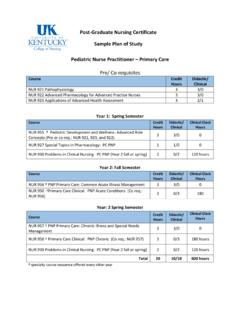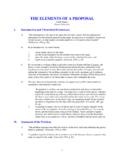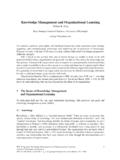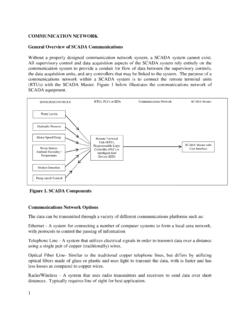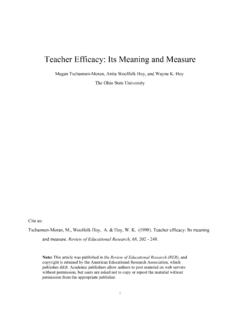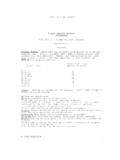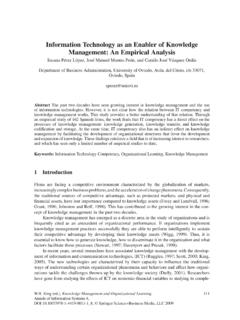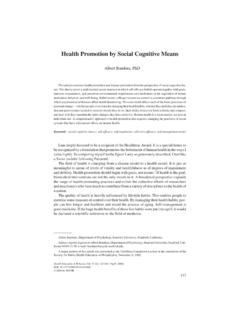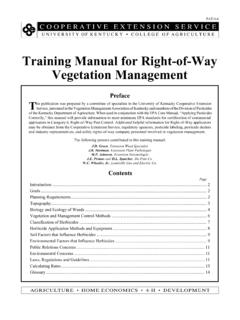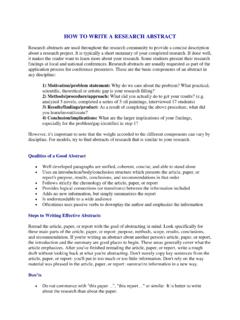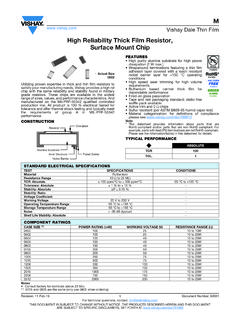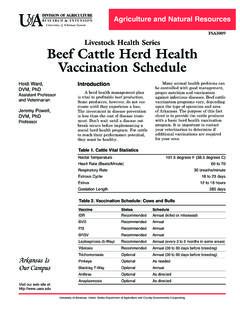Transcription of Dale H. Schunk Frank Pajares Purdue University Emory ...
1 Development of Academic Self-Efficacy1 The Development of Academic Self-EfficacyDale H. Schunk Frank Pajares Purdue University Emory University Chapter in A. Wigfield & J. Eccles (Eds.), Development of achievement Diego: Academic Press. Requests for reprints should be addressed to: Dale H. Schunk , 1446 LAEB Room 5108, Purdue University , West Lafayette, IN 47907-1446 Development of Academic Self-Efficacy2 The Development of Academic Self-EfficacyCurrent views of cognitive development stress that the construction of knowledge variesas a function of an individual s developmental level and experiences (Meece, 1997; Siegler,1991). These views focus on changes in processing functions; for example, attention, encoding,retrieval, metacognition, use of similar fashion, contemporary motivation theories focus on the cognitive and affectiveprocesses that instigate, direct, and sustain human action.
2 Researchers investigate the operationof such processes as goals, expectations, attributions, values, and emotions (Pintrich & Schunk ,1996).In this chapter we focus on the development of one type of motivational process:perceived self-efficacy. Self-efficacy refers to beliefs about one s capabilities to learn or performbehaviors at designated levels (Bandura, 1986, 1997). Much research shows that self-efficacyinfluences academic motivation, learning, and achievement ( Pajares , 1996; Schunk , 1995).Self-efficacy is grounded in a larger theoretical framework known as social cognitivetheory, which postulates that human achievement depends on interactions between one sbehaviors, personal factors ( , thoughts, beliefs), and environmental conditions (Bandura,1986, 1997). Learners obtain information to appraise their self-efficacy from their actualperformances, their vicarious experiences, the persuasions they receive from others, and theirphysiological reactions.
3 Self-efficacy beliefs influence task choice, effort, persistence, resilience,and achievement (Bandura, 1997; Schunk , 1995). Compared with students who doubt theirlearning capabilities, those who feel efficacious for learning or performing a task participate Development of Academic Self-Efficacy3more readily, work harder, persist longer when they encounter difficulties, and achieve at ahigher to Other ConstructsThere are motivation constructs that seem conceptually similar to self-efficacy. Outcomeexpectations, the consequences expected from one s own actions, are related to self-efficacybeliefs but they are not synonymous. For example, an efficacious student may believe that shehas the capability to learn mathematics. Nonetheless, she may also believe that despite herperceived capability she will not earn a good grade in mathematics class because the instructordoes not like beliefs, one s collective self-perceptions that are formed throughexperiences with, and interpretations of the environment, and which are heavily influenced byreinforcements and evaluations by significant others (Shavelson & Bolus, 1982) also differ fromself-efficacy beliefs.
4 Whereas self-efficacy is concerned with judgments about capabilities, self-concept includes the feelings of self-worth that accompany competence beliefs ( Pajares & Schunk , in press).Self-efficacy also differs from effectance motivation, which is the motivation to interacteffectively with one s environment and control critical aspects (White, 1959). In young childreneffectance motivation is diffuse and affects many interactions. With development it becomesmore specialized and manifests itself in achievement behaviors in various school subjects. Likeself-efficacy, effectance motivation includes perceived capabilities for influencing importantaspects of one s life. Unlike self-efficacy, effectance motivation is a global construct and lacksself-efficacy s specificity. Development of Academic Self-Efficacy4 The notion of perceived control also differs from self-efficacy.
5 People who believe theycan control what they learn and perform are more apt to initiate and sustain behaviors directedtoward those ends than are individuals who hold a low sense of control over their capabilities(Bandura, 1997). Perceived control is generic; thus, it is meaningful to speak of perceivedcontrol over learning or performing and over outcomes. Further, perceived control is only oneaspect of self-efficacy. Other factors that influence self-efficacy include perceptions of ability,social comparisons, attributions, time available, and perceived importance. People may believethey can control their use of learning strategies, effort, and persistence, yet still hold a low senseof self-efficacy for learning because they feel that the learning is unimportant and do not want toinvest time in of Self-EfficacyFamilial Influence on Self-EfficacyBeginning in infancy, parents and caregivers provide experiences that differentiallyinfluence children s self-efficacy.
6 Home influences that help children interact effectively withthe environment positively affect self-efficacy (Bandura, 1997; Meece, 1997). Initial sources ofself-efficacy are centered in the family, but the influence is bidirectional. Parents who provide anenvironment that stimulates youngsters curiosity and allows for mastery experiences help tobuild children s self-efficacy. In turn, children who display more curiosity and exploratoryactivities promote parental environments are rich in interesting activities that arouse children s curiosity andoffer challenges that can be met, children are motivated to work on the activities and therebylearn new information and skills (Meece, 1997). There is much variability in homeenvironments. Some contain materials such as computers, books, and puzzles that stimulate Development of Academic Self-Efficacy5children s thinking.
7 Parents who are heavily invested in their children s cognitive developmentmay spend time with them on learning. Other homes do not have these resources and adults maydevote little time to children s who provide a warm, responsive and supportive home environment, whoencourage exploration and stimulate curiosity, and who provide play and learning materialsaccelerate their children s intellectual development (Meece, 1997). Parents also are keyproviders of self-efficacy information. Parents who arrange for varied mastery experiencesdevelop more-efficacious youngsters than do parents who arrange fewer opportunities (Bandura,1997). Such experiences occur in homes enriched with activities and in which children havefreedom to respect to vicarious sources, parents who teach children ways to cope withdifficulties and model persistence and effort strengthen children s self-efficacy. As childrengrow, peers become increasingly important.
8 Parents who steer their children toward efficaciouspeers provide further vicarious boosts in also are prime sources of persuasive information. Parents who encourage theiryoungsters to try different activities and support their efforts help to develop children who feelmore capable of meeting challenges (Bandura, 1997). Self-efficacy suffers in homes in whichnovel activities are InfluencePeers influence children s self-efficacy in various ways. One means is through modelsimilarity. Observing similar others succeed can raise observers self-efficacy and motivate themto perform the task if they believe that they, too, will be successful ( Schunk , 1987). Conversely,observing others fail can lead students to believe that they lack the competence to succeed and Development of Academic Self-Efficacy6dissuade them from attempting the task.
9 Model similarity is most influential for students who areuncertain about their performance capabilities, such as those lacking task familiarity andinformation to use in judging self-efficacy or those who have experienced difficulties and holddoubts (Bandura, 1986; Schunk , 1987). Model similarity is potent among children andadolescents because peers are similar in many ways and students at these developmental levelsare unfamiliar with many influence also operates through peer networks, or large groups of peers with whomstudents associate. Students in networks tend to be similar to one another (Cairns, Cairns, &Neckerman, 1989), which enhances the likelihood of influence by modeling. Networks helpdefine students opportunities for interactions and observations of others interactions, as well astheir access to activities (Dweck & Goetz, 1978). Over time, network members become moresimilar to one another.
10 Discussions between friends influence their choices of activities andfriends often make similar choices (Berndt & Keefe, 1992).Peer groups promote motivational socialization. Changes in children s motivationalengagement across the school year are predicted accurately by their peer group membership atthe start of the year (Kindermann, McCollam, & Gibson, 1996). Children affiliated with highlymotivated groups change positively across the school year; those in less-motivated groupschange , Brown, and Dornbusch (1996) tracked students from high school entranceuntil their senior year and found developmental patterns in the influence of peer pressure onmany activities including academic motivation and performance. Peer pressure rises duringchildhood and peaks around grade 8 or 9 but then declines through high school. A key time ofinfluence is roughly between ages 12 and 16, a time during which parental involvement in Development of Academic Self-Efficacy7children s activities declines.
